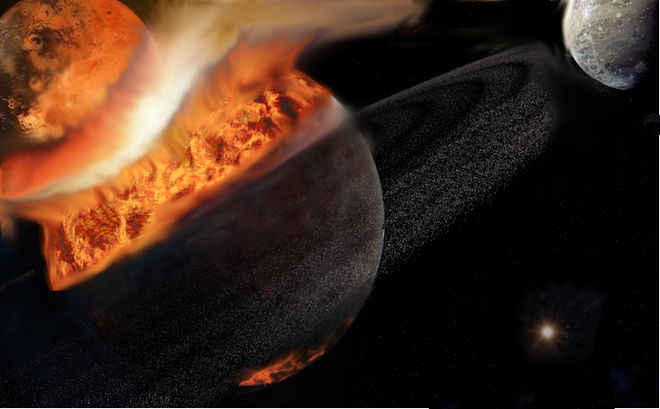
Lunar formation in the multiple-impact scenario. Moon- to Mars-sized impactors strike the Earth and leave a disk of debris orbiting the planet. The debris forms “moonlets” and migrate farther away from the Earth due to a tidal interaction, but eventually settle at a distance known as the Hill radius. Here, the moonlets merge to eventually form the moon..
The Moon, and the question of how it was formed, has long been a source of fascination and wonder. Now, a team of Israeli researchers suggests that the Moon we see every night is not Earth’s first moon, but rather the last in a series of moons that orbited Earth in the past. The newly proposed theory by Prof. Hagai Perets, of Technion, and Weizmann Institute Profs. Raluca Rufo (lead author)and Oded Aharonson, runs counter to the commonly held “giant impact” paradigm that the moon is a single object that was formed following a single giant collision between a small Mars-like planet and the ancient Earth.
“Our model suggests that the ancient Earth once hosted a series of moons, each one formed from a different collision with the proto-Earth,” said Prof. Perets. “It’s likely that such moonlets were later ejected, or collided with Earth or with each other to form bigger moons.” To check the conditions for the formation of such mini-moons or moonlets the researchers ran 800 simulations of impacts with Earth. The new model is consistent with science’s current understanding of the formation of Earth. In its last stages of the growth, Earth experienced many giant impacts with other bodies. Each of these impacts contributed more material to the proto-Earth, until it reached its current size.

An artistic depiction of a collision between two planetary bodies that will form a new moon, while a pre-existing moon already orbits the proto-Earth
“We believe Earth had many previous moons,” said Prof. Perets, who added that, “a previously formed moon could therefore already exist when another moon-forming giant impact occurs.” The tidal forces from Earth could cause moons to slowly migrate outwards (the current Moon is slowly doing that at a pace of about 1 cm a year). A pre-existing moon would slowly move out by the time another moon forms. However, their mutual gravitational attraction would eventually cause the moons to affect each other, and change their orbits.
“It’s likely that small moons formed through the process could cross orbits, collide and merge,” said lead author Prof. Rufo. “A long series of such moon-moon collisions could gradually build-up a bigger moon – the Moon we see today.” http://www.newswise.com/articles/how-earth-s-previous-moons-collided-to-form-the-moon







Recent Comments